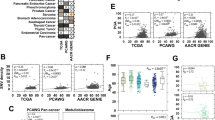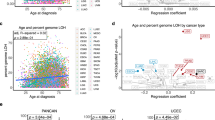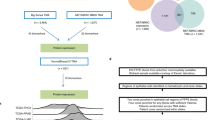Abstract
A striking link exists between advanced age and increased incidence of cancer. Here I review how several of the age-related molecular and physiological changes might act in concert to promote cancer, and in particular epithelial carcinogenesis. Experimental data indicate that the aged, cancer-prone phenotype might represent the combined pathogenetic effects of mutation load, epigenetic regulation, telomere dysfunction and altered stromal milieu. Further verification of the role of these effects should in turn lead to the design of effective therapeutics for the treatment and prevention of cancer in the aged.
This is a preview of subscription content, access via your institution
Access options
Subscribe to this journal
Receive 51 print issues and online access
$199.00 per year
only $3.90 per issue
Buy this article
- Purchase on Springer Link
- Instant access to full article PDF
Prices may be subject to local taxes which are calculated during checkout




Similar content being viewed by others
References
American Cancer Society. Cancer Facts and Figures 2000 1–7 (American Cancer Society, Atlanta, 2000).
Bishop, J. M. Molecular themes in oncogenesis. Cell 64, 235–248 (1991).
Nowell, P. C. The clonal evolution of tumor cell populations. Science 194, 23–28 (1976).
Vogelstein, B. et al. Genetic alterations during colorectal-tumor development. N. Engl. J. Med. 319, 525–532 (1988).
Balaban, G. B., Herlyn, M., Clark, W. H. Jr & Nowell, P. C. Karyotypic evolution in human malignant melanoma. Cancer Genet. Cytogenet. 19, 113–122 ( 1986).
Naylor, S. L., Johnson, B. E., Minna, J. D. & Sakaguchi, A. Y. Loss of heterozygosity of chromosome 3p markers in small-cell lung cancer . Nature 329, 451–454 (1987).
James, C. D. et al. Clonal genomic alterations in glioma malignancy stages. Cancer Res. 48, 5546–5551 (1988).
Rabinovitch, P. S., Reid, B. J., Haggitt, R. C., Norwood, T. H. & Rubin, C. E. Progression to cancer in Barrett's esophagus is associated with genomic instability. Lab. Invest. 60, 65–71 ( 1988).
Harman, D. Aging: a theory based on free-radical and radiation chemistry. J. Gerontol. 6, 298–300 (1956).
Ames, B. N., Shigenaga, M. K. & Hagen, T. M. Oxidants, antioxidants and the degenerative diseases of aging. Proc. Natl Acad. Sci. USA 90, 7915–7922 (1993).
Minnick, D. T. & Kunkel, T. A. DNA synthesis errors, mutators and cancer. Cancer Surv. 28, 3–20 (1996).
Oller, A. R., Rastogi, P., Morgenthaler, S. & Thilly, W. G. A statistical model to estimate variance in long term-low dose mutation assays: testing of the model in a human lymphoblastoid mutation assay. Mutat. Res. 216, 149–161 (1989).
Jackson, A. L. & Loeb, L. A. The mutation rate and cancer. Genetics 148, 1483– 1490 (1998).
Armitage, P. & Doll, R. The age distribution of cancer and a multi-stage theory of carcinogenesis. Br. J. Cancer 8, 1–12 (1954).
Renan, M. J. How many mutations are required for tumorigenesis? Implications from human cancer data. Mol. Carcinog. 7, 139– 146 (1993).
Hanahan, D. & Weinberg, R. A. The hallmarks of cancer. Cell 100, 57–70 ( 2000).
Loeb, L. A. Mutator phenotype may be required for multistage carcinogenesis. Cancer Res. 51, 3075–3079 (1991).
Kinzler, K. W. & Vogelstein, B. Lessons from hereditary colorectal cancer. Cell 87, 159 –170 (1996).
Lengauer, C., Kinzler, K. W. & Vogelstein, B. Genetic instability in colorectal cancers. Nature 386, 623–627 ( 1997).
Gray, J. W. & Collins, C. Genome changes and gene expression in human solid tumors. Carcinogenesis 21, 443–452 (2000).
Weinberg, R. The cat and mouse games that genes, viruses, and cells play. Cell 88, 573–575 ( 1997).
Turker, M. S. Estimation of mutation frequencies in normal mammalian cells and the development of cancer. Semin. Cancer Biol. 8, 407– 419 (1998).
Dolle, M. E. et al. Rapid accumulation of genome rearrangements in liver but not in brain of old mice. Nature Genet. 17, 431–434 (1997).
Dolle, M. E., Snyder, W. K., Gossen, J. A., Lohman, P. H. & Vijg, J. Distinct spectra of somatic mutations accumulated with age in mouse heart and small intestine. Proc. Natl Acad. Sci. USA 97, 8403–8408 (2000).
Vijg, J. & Dolle, M. E. T. in Handbook of the Biology of Ageing 5th edn (eds Masoro, E. J. & Austad, S. N.) (Academic, in the press).
Curtis, H. & Crowley, C. Chromosome aberrations in liver cells in relation to the somatic mutation theory of aging. Radiat. Res. 19, 337–344 ( 1963).
Ly, D. H., Lockhart, D. J., Lerner, R. A. & Schultz, P. G. Mitotic misregulation and human aging. Science 287, 2486–2492 (2000).
Ramsey, M. J. et al. The effects of age and lifestyle factors on the accumulation of cytogenetic damage as measured by chromosome painting. Mutat. Res. 338, 95–106 ( 1995).
Jacobs, P., Brunton, M., Brown, W., Doll, R. & Goldstein, H. Change of human chromosome count distributions with age: evidence for a sex difference. Nature 197, 1080–1081 (1963).
Tucker, J. D., Spruill, M. D., Ramsey, M. J., Director, A. D. & Nath, J. Frequency of spontaneous chromosome aberrations in mice: effects of age. Mutat. Res. 425 , 135–141 (1999).
Moriwaki, S., Ray, S., Tarone, R. E., Kraemer, K. H. & Grossman, L. The effect of donor age on the processing of UV-damaged DNA by cultured human cells: reduced DNA repair capacity and increased DNA mutability. Mutat. Res. 364, 117– 123 (1996).
Goukassian, D. et al. Mechanisms and implications of the age-associated decrease in DNA repair capacity. FASEB J. 14, 1325 –1334 (2000).
Liu, S. C., Parsons, C. S. & Hanawalt, P. C. DNA repair response in human epidermal keratinocytes from donors of different age. J. Invest. Dermatol. 79, 330–335 (1982).
Kolodner, R. D. et al. Germ-line msh6 mutations in colorectal cancer families. Cancer Res. 59, 5068–5074 (1999).
Baylin, S. B. & Herman, J. G. DNA hypermethylation in tumorigenesis: epigenetics joins genetics. Trends Genet. 16, 168–174 (2000).
Jones, P. A. & Laird, P. W. Cancer epigenetics comes of age . Nature Genet. 21, 163– 167 (1999).
Issa, J. P. et al. Methylation of the oestrogen receptor CpG island links ageing and neoplasia in human colon. Nature Genet. 7, 536–540 (1994).
Issa, J. P. Aging, DNA methylation and cancer. Crit. Rev. Oncol. Hematol. 32, 31–43 (1999).
Cormier, R. T. & Dove, W. F. Dnmt1N/+ reduces the net growth rate and multiplicity of intestinal adenomas in C57BL/6-multiple intestinal neoplasia (Min)/+ mice independently of p53 but demonstrates strong synergy with the modifier of Min 1(AKR) resistance allele. Cancer Res. 60, 3965–3970 ( 2000).
Laird, P. W. et al. Suppression of intestinal neoplasia by DNA hypomethylation . Cell 81, 197–205 (1995).
Rhee, I. et al. CpG methylation is maintained in human cancer cells lacking DNMT1 . Nature 404, 1003–1007 (2000).
DePinho, R. A. & Sherr, C. J. Cellular senescence: mitotic clock or culture shock? Cell 102, 407–410 (2000).
Atkin, N. B. Solid tumor cytogenetics. Progress since 1979. Cancer Genet. Cytogenet. 40, 3–12 (1989 ).
Artandi, S. E. et al. Telomere dysfunction promotes non-reciprocal translocations and epithelial cancers in mice. Nature 406, 641–645 (2000).
Greider, C. Telomerase activity, cell proliferation, and cancer. Proc. Natl Acad. Sci. USA 95, 90 (1998).
Harley, C. B., Futcher, A. B. & Greider, C. W. Telomeres shorten during ageing of human fibroblasts . Nature 345, 458–460 (1990).
Hastie, N. D. et al. Telomere reduction in human colorectal carcinoma and with ageing. Nature 346, 866– 868 (1990).
Allsopp, R. C. et al. Telomere length predicts replicative capacity of human fibroblasts . Proc. Natl Acad. Sci. USA 89, 10114– 10118 (1992).
Chadeneau, C., Hay, K., Hirte, H. W., Gallinger, S. & Bacchetti, S. Telomerase activity associated with acquisition of malignancy in human colorectal cancer. Cancer Res. 55, 2533–2536 (1995).
Kipling, D. & Cooke, H. J. Hypervariable ultra-long telomeres in mice. Nature 347, 400– 402 (1990).
Prowse, K. R. & Greider, C. W. Developmental and tissue-specific regulation of mouse telomerase and telomere length. Proc. Natl Acad. Sci. USA 92, 4818–4822 (1995).
Broccoli, D., Godley, L. A., Donehower, L. A., Varmus, H. E. & de, L. T. Telomerase activation in mouse mammary tumors: lack of detectable telomere shortening and evidence for regulation of telomerase RNA with cell proliferation. Mol. Cell. Biol. 16, 3765–3772 (1996).
Greenberg, R. A., Allsopp, R. C., Chin, L., Morin, G. B. & DePinho, R. A. Expression of mouse telomerase reverse transcriptase during development, differentiation and proliferation. Oncogene 16, 1723–1730 ( 1998).
Martin-Rivera, L., Herrera, E., Albar, J. & Blasco, M. A. Expression of mouse telomerase catalytic subunit in embryos and adult tissues. Proc. Natl Acad. Sci. USA 95, 10471– 10476 (1998).
Counter, C. M. et al. Telomere shortening associated with chromosome instability is arrested in immortal cells which express telomerase activity. EMBO J. 11, 1921–1929 ( 1992).
McClintock, B. The stability of broken ends of chromosomes in Zea mays. Genetics 26, 234–282 ( 1941).
Nishizaki, T. et al. Genetic alterations in primary breast cancers and their metastases: direct comparison using modified comparative genomic hybridization. Genes Chromosomes Cancer 19, 267–272 (1997).
Buerger, H. et al. Comparative genomic hybridization of ductal carcinoma in situ of the breast-evidence of multiple genetic pathways. J. Pathol. 187, 396–402 ( 1999).
Al-Mulla, F., Keith, W. N., Pickford, I. R., Going, J. J. & Birnie, G. D. Comparative genomic hybridization analysis of primary colorectal carcinomas and their synchronous metastases . Genes Chromosomes Cancer 24, 306– 314 (1999).
Tang, R., Cheng, A. J., Wang, J. Y. & Wang, T. C. Close correlation between telomerase expression and adenomatous polyp progression in multistep colorectal carcinogenesis. Cancer Res. 58, 4052–4054 (1998).
Lee, H. W. et al. Essential role of mouse telomerase in highly proliferative organs. Nature 392, 569– 574 (1998).
Rudolph, K. L. et al. Longevity, stress response, and cancer in aging telomerase-deficient mice. Cell 96, 701–712 (1999).
de Lange, T. Activation of telomerase in a human tumor. Proc. Natl Acad. Sci. USA 91, 2882–2885 ( 1994).
Foley, K. P. & Eisenman, R. N. Two MAD tails: what the recent knockouts of Mad1 and Mxi1 tell us about the MYC/MAX/MAD network. Biochim. Biophys. Acta 1423, M37–M47 (1999).
Rudolph, K. L., Chang, S., Millard, M., Schreiber-Agus, N. & DePinho, R. A. Inhibition of experimental liver cirrhosis in mice by telomerase gene delivery. Science 287, 1253–1258 (2000).
Kitada, T., Seki, S., Kawakita, N., Kuroki, T. & Monna, T. Telomere shortening in chronic liver diseases. Biochem. Biophys. Res. Commun. 211, 33– 39 (1995).
Miura, N. et al. Progressive telomere shortening and telomerase reactivation during hepatocellular carcinogenesis. Cancer Genet. Cytogenet. 93, 56–62 (1997).
Urabe, Y. et al. Telomere length in human liver diseases. Liver 16, 293–297 (1996).
Weinberg, R. A. The retinoblastoma protein and cell cycle control. Cell 81, 323–330 (1995).
Debbas, M. & White, E. Wild-type p53 mediates apoptosis by E1A, which is inhibited by E1B. Genes Dev. 7, 546–554 (1993).
Symonds, H. et al. p53-dependent apoptosis suppresses tumor growth and progression in vivo. Cell 78, 703–711 (1994).
Morgenbesser, S. D., Williams, B. O., Jacks, T. & DePinho, R. A. p53-dependent apoptosis produced by Rb-deficiency in the developing mouse lens. Nature 371, 72–74 (1994).
Kim, N. W. et al. Specific association of human telomerase activity with immortal cells and cancer. Science 266, 2011– 2015 (1994).
Blasco, M. A., Rizen, M., Greider, C. W. & Hanahan, D. Differential regulation of telomerase activity and telomerase RNA during multi-stage tumorigenesis. Nature Genet. 12, 200– 204 (1996).
Greenberg, R. A. et al. Short dysfunctional telomeres impair tumorigenesis in the INK4a(Δ2/3) cancer-prone mouse. Cell 97, 515–525 (1999).
Hahn, W. C. et al. Creation of human tumour cells with defined genetic elements . Nature 400, 464–468 (1999).
Chin, L. & DePinho, R. A. Flipping the oncogene switch: illumination of tumor maintenance and regression. Trends Genet. 16, 147–150 ( 2000).
Chin, L. et al. Essential role for oncogenic RAS in tumour maintenance. Nature 400, 468–472 ( 1999).
Pelengaris, S., Littlewood, T., Khan, M., Elia, G. & Evan, G. Reversible activation of c-Myc in skin: induction of a complex neoplastic phenotype by a single oncogenic lesion. Mol. Cell 3 , 565–577 (1999).
Gelman, R., Watson, A., Bronson, R. & Yunis, E. Murine chromosomal regions correlated with longevity. Genetics 118, 693–704 (1988).
Cunha, G. & Hom, Y. Role of mesenchymal-epithelial interactions in mammary gland development. J. Mamm. Gland Biol. Neoplasia 1, 21–35 (1996).
Olumi, A. F. et al. Carcinoma-associated fibroblasts direct tumor progression of initiated human prostatic epithelium. Cancer Res. 59, 5002–5011 (1999).
Dimri, G. P. et al. A biomarker that identifies senescent human cells in culture and in aging skin in vivo. Proc. Natl Acad. Sci. USA 92, 9363–9367 (1995).
Shelton, D. N., Chang, E., Whittier, P. S., Choi, D. & Funk, W. D. Microarray analysis of replicative senescence. Curr. Biol. 9, 939– 945 (1999).
Campisi, J. Aging and cancer: the double-edged sword of replicative senescence. J. Am. Geriatr. Soc. 45, 482–488 (1997).
Serrano, M., Lin, A. W., McCurrach, M. E., Beach, D. & Lowe, S. W. Oncogenic ras provokes premature cell senescence associated with accumulation of p53 and p16INK4a. Cell 88, 593–602 ( 1997).
Di Leonardo, A., Linke, S. P., Clarkin, K. & Wahl, G. M. DNA damage triggers a prolonged p53-dependent G1 arrest and long-term induction of Cip1 in normal human fibroblasts. Genes Dev. 8, 2540–2551 (1994).
Coussens, L. M. et al. Inflammatory mast cells up-regulate angiogenesis during squamous epithelial carcinogenesis. Genes Dev. 13, 1382–1397 (1999).
Bergers, G. et al. Matrix metalloprotein-9 triggers the angiogenic switch during carcinogenesis. Nature Cell Biol. 2, 737 –744 (2000).
Coussens, L., Tinkle, C., Hanahan, D. & Werb, Z. MMP-9 supplied by bone marrow-derived cells contributes to skin carcinogenesis. Cell (in the press).
Millis, A. J., Hoyle, M., McCue, H. M. & Martini, H. Differential expression of metalloproteinase and tissue inhibitor of metalloproteinase genes in aged human fibroblasts. Exp. Cell Res. 201, 373 –379 (1992).
Sternlicht, M. D. et al. The stromal proteinase MMP3/stromelysin-1 promotes mammary carcinogenesis. Cell 98, 137– 146 (1999).
Robertson, K. D. & Jones, P. A. DNA methylation: past, present and future directions. Carcinogenesis 21, 461–467 (2000).
Piantanelli, L. Cancer and aging: from the kinetics of biological parameters to the kinetics of cancer incidence and mortality. Ann. NY Acad. Sci. 521, 99–109 (1988).
Schwartz, R. A. Skin Cancer: Recognition and Management (Springer, New York, 1988).
Acknowledgements
I apologize to my colleagues whose relevant work I was unable to cite owing to space and reference limitations. I thank J. Vijg, D. Hanahan, J. Campisi, J.-P. Issa, N. Schreiber-Agus, G. Merlino, S. Mellis, L. Chin, S. Weiler and members of my laboratory for helpful discussions and critical comments. R.A.D. is supported by the National Institutes of Health and is an American Cancer Society Research Professor and a Steven and Michele Kirsch Foundation Investigator.
Author information
Authors and Affiliations
Corresponding author
Rights and permissions
About this article
Cite this article
DePinho, R. The age of cancer. Nature 408, 248–254 (2000). https://doi.org/10.1038/35041694
Issue Date:
DOI: https://doi.org/10.1038/35041694
This article is cited by
-
Biomarkers of UVB radiation-related senescent fibroblasts
Scientific Reports (2024)
-
Analysis of physical function, muscle strength, and pulmonary function in surgical cancer patients: a prospective cohort study
Supportive Care in Cancer (2023)
-
Biochemistry—Not Oncogenes—May Demystify and Defeat Cancer
Oncology and Therapy (2023)
-
The Significance of Unsampled Microscopic Thyroid Carcinomas in Multinodular Goiter
Endocrine Pathology (2023)
-
Use of Systemic Therapies for Treatment of Psoriasis in Patients with a History of Treated Solid Tumours: Inference-Based Guidance from a Multidisciplinary Expert Panel
Dermatology and Therapy (2023)
Comments
By submitting a comment you agree to abide by our Terms and Community Guidelines. If you find something abusive or that does not comply with our terms or guidelines please flag it as inappropriate.



